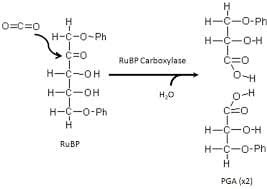Introduction
The Calvin Cycle—sometimes called the C3 Cycle or Calvin-Benson Cycle—is a series of essential processes plants use to turn carbon dioxide into energy-rich sugars. Named after scientist Melvin Calvin, who first described it in the 1940s, the Calvin Cycle takes place in the stroma of chloroplasts and works independently of light. While light-dependent reactions capture and convert sunlight into chemical energy, the Calvin Cycle quietly builds the molecules that plants use as their main source of energy.
In this article, we’ll explore what makes the Calvin Cycle such an important part of photosynthesis, how it works, and why it’s vital to life on Earth.
Calvin Cycle
The Calvin Cycle is a part of photosynthesis where plants take in carbon dioxide (CO₂) and, with the help of other molecules, transform it into sugars like glucose. This process doesn’t require sunlight directly; instead, it uses energy-carrying molecules made during the sunlight-dependent parts of photosynthesis.
This cycle is essential for carbon fixation, where CO₂ from the air is captured and turned into organic compounds. These compounds eventually become glucose and other sugars, which the plant uses for energy, growth, and building material.
Calvin Cycle Importance
The Calvin Cycle is at the heart of how plants store energy and grow. Here are three key reasons it matters:
- Carbon Fixation: The Calvin Cycle brings CO₂ into the plant’s cellular processes, allowing it to form energy-rich compounds.
- Energy Storage: By creating carbohydrates, the Calvin Cycle locks energy from sunlight in a form the plant can use or store.
- Biomolecule Creation: Beyond energy, it also helps produce many compounds the plant needs to build tissues and grow.
Breaking Down the Calvin Cycle’s Stages
The Calvin Cycle has three main stages that work together to produce sugars from CO₂:

1. Carbon Fixation
The cycle starts when CO₂ from the air attaches to a five-carbon molecule called ribulose-1,5-bisphosphate (RuBP). This reaction is powered by an enzyme called RuBisCO, which is essential for nearly all photosynthetic organisms.
Adding CO₂: RuBisCO helps bind CO₂ to RuBP, producing a short-lived six-carbon molecule.
Splitting the Molecule: This molecule quickly breaks down into two three-carbon compounds known as 3-phosphoglycerate (3-PGA).
2. Reduction Phase
In this phase, the Calvin Cycle adds energy to the three-carbon molecules, turning them into glyceraldehyde-3-phosphate (G3P), a simple sugar.
Adding Phosphate: Each 3-PGA molecule gets a phosphate group from ATP, a molecule that stores energy.
Reduction Step: The modified molecules are then converted to G3P using electrons from NADPH, another energy-carrying molecule.
3. Regeneration of RuBP
The final stage is all about resetting the cycle. To keep the process going, some of the G3P molecules are used to regenerate RuBP, which lets the cycle start again with new CO₂.
Rearranging G3P: Most of the G3P created is used to make more RuBP through a series of complex steps.
Using ATP: This regeneration process uses ATP again to make sure RuBP is ready for the next round of CO₂ capture.
How ATP and NADPH Fuel the Calvin Cycle
ATP and NADPH are the “batteries” that keep the Calvin Cycle running. These molecules are produced during the light-dependent reactions and store the energy needed for the Calvin Cycle to make sugars from CO₂.
ATP gives energy for chemical reactions in the cycle, especially in the reduction and regeneration phases.
NADPH provides electrons that reduce molecules during the process, turning them into forms the plant can use to make sugars.
Calvin Cycle product
The main product of the Calvin Cycle is glyceraldehyde-3-phosphate (G3P), a three-carbon sugar. G3P can then be used to make glucose and other carbohydrates, which are essential for the plant’s energy and structure.
One G3P Per Cycle: For each round of the Calvin Cycle, one G3P exits the cycle, which the plant uses to form glucose and other sugars.
Glucose Formation: After two rounds of the cycle, two G3P molecules combine to make glucose.
This sugar is crucial, as it forms the energy source plants and other organisms need to survive.
How Calvin Cycle’s Efficient
Several factors impact how well the Calvin Cycle works, including:
Temperature: Like other enzymes, the enzymes in the Calvin Cycle have an optimal temperature range. Too high or low, and the cycle slows down.
CO₂ Levels: Higher CO₂ levels can speed up the cycle, while lower levels reduce its efficiency.
Light Availability: Although light isn’t directly involved in the Calvin Cycle, it drives the creation of ATP and NADPH, which power the cycle.
Water Supply: Water stress can limit ATP and NADPH production, slowing down the Calvin Cycle as a result.
How the Calvin Cycle Impacts Ecosystems and Agriculture
The Calvin Cycle isn’t just vital for individual plants; it has a huge impact on entire ecosystems and even agriculture.
- Ecosystem Foundation: Plants, by producing glucose through the Calvin Cycle, support the whole food chain.
- Climate Impact: The cycle captures CO₂ from the air, which helps reduce greenhouse gases.
- Better Crop Yields: Understanding the Calvin Cycle allows scientists and farmers to boost crop production and efficiency, feeding more people worldwide.
Future Innovations with the Calvin Cycle
Science and technology are constantly finding ways to make the Calvin Cycle work even better, which could have exciting impacts in areas like climate change and food production.
- Improving RuBisCO: Scientists are working on ways to make RuBisCO more efficient at capturing CO₂, potentially leading to faster plant growth and higher yields.
- Artificial Photosynthesis: Creating systems that mimic the Calvin Cycle could help us capture CO₂ for renewable energy sources.
- Boosting Crop Resilience: Through genetic engineering, plants may one day be able to withstand harsh conditions, protecting food supplies against climate change.
The Calvin Cycle may happen in the background of photosynthesis, but its role is vital. This cycle helps plants capture and store energy, supporting nearly all life on Earth and stabilizing our climate. From the food we eat to the oxygen we breathe, the Calvin Cycle is one of nature’s most crucial processes.




